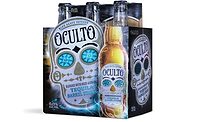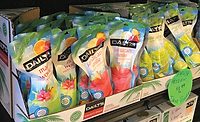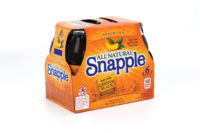It seems as though retail space is more like a battle ground. Different companies and categories clutter the shelves fighting for consumers’ attention. Retailers don’t make it easy for beverage brands to get and keep that space either. So, how do beverage brands fight back? One of the answers is with their use of secondary packaging.
Although consumer demand is the overall driver, retailers also can have an effect on a beverage company, experts say. Additionally, changes within retail channels have caused secondary packaging to fight a war vying for consumers’ attention.
To highlight this fact, Proactive Packaging and Displays, Ontario, Calif., recently released a report titled “The New Retail Math.”
“The hurdles your brand faces today are numerous,” the report states. “More than ever, your packaging has to sell your product at a faster rate.”
As day-to-day life gets more hectic, time spent browsing in the store decreases, resulting in fewer impulse buys.
“Retail is really changing today,” says Charles Pavia, director of marketing at Proactive Packaging and Display. “Most of the action is happening around the perimeter of the store … and the beverages tend to be in the center of the store. That means that your packaging has to work extra hard.”
According to the report, the average time spent shopping decreased 12.5 percent, down to 43 minutes, between 2003 and 2011. “Today, shopping is more like a well-planned, precisely executed military campaign,” the report states. “[M]eaning for impulse purchases to occur, your packaging has to perform at a much higher level.”
Next there is the battle for shelf space. “Your product, to the retailer, is either a profit-maker or a place-taker,” Pavia says. “If it’s a place-taker, it’s not going to be on the shelf for long. Every day, each product has got to earn its shelf position.”
Fighting back
Beverage brands are fighting back with secondary packaging. One way they’re doing this is by using secondary packaging for display as well as shipping, according to Don Reggio, marketing director of corrugated containers at West Rock, formally Rock Tenn Corrugated. “The biggest thing right now is retail-ready designs,” he says.
West Rock offers a corrugated shipper that is perforated for easy transformation into a displayer. “If the secondary packaging is just a shipper, it ships to the store, and the store unboxes it and puts it on a shelf. Then all it did is protect in transit. If the shipper is to be displayed, then the brand image is usually printed on the case, so the customer recognizes the brand,” Reggio says.
A recent example comes from Kraft Food Group Inc.’s Capri Sun brand. The brand announced it partnered with Illumination Entertainment and Universal Picture’s film “Minions.” The campaign promises a visually outstanding in-store presence striving to catch consumers’ attention and boost impulse purchases, the company says.
Additionally, Reggio says that precision is important for secondary packaging. ”We have a patented design on forming containers around a fixed mandrel,” Reggio says. “We have a patented design on containers around precision manuform technology.
“The mandrel creates a form of the interior of the box, and the corrugated is wrapped around it and glued,” he continues. “So, when it’s ejected out of the machine, it’s dimensions are very accurate. It’s the same box every time. The precision allows for very tight packing, which allows for high speeds and robotics.”
According to Reggio, bending the corrugated board more than 90 degrees at the corner joints causes the fibers to break down, weakening the corners of the structure. “With the mandrel-formed case, the board is never folded past the finished corner,” he says.
Reggio says that West Rock also is exploring mixed-fiber substrates. The bottom of the package is solid fiber, and the top is corrugate. “It’s a two-piece design that’s also automatable,” he explains. “This allows for structure to support and protect in the store and in transit. Once in the store, the corrugated hood can be popped off, leaving a four-color tray on the shelf, which helps define shelf space.”
Consumers are being drawn to brands with more eco-friendly packaging options, experts say.
According to Chris Turner, director of sales at Roberts PolyPro, Charlotte, N.C., the company offers a convenient multipack that uses 35 percent less plastic than its competitors.
“Consumers are looking for a convenient way to carry and dispense beverages,” Turner says. “They also are very focused on the sustainability of the packaging and recyclability.”
Charles Mace, vice president of sales at Zumbiel Packaging, Hebron, Ky., agrees, “A lot of companies are looking at the whole sustainability feature of paperboard,” he says. “Even if it does hit a landfill, it’s biodegradable.”
The final battle strategy focuses on graphics and product information. Secondary packaging now is being utilized to offer more information and exciting consumer experiences.
Consumers want to be able to find nutrition information quickly and easily.
“Secondary packaging has begun to include a lot of information that used to be on the primary container only,” says Tom Zumbiel, marketing and sustainability director at Zumbiel Packaging. “We do a lot more printing of ingredient labels and health statements, etc.
Proactive’s Pavia says this has been especially noticeable with pouch products. “The consumer doesn’t see the pouch. They buy a carton that has 18 pouches in it, so they’re going to want to know what’s in it,” he explains.
Pavia explains that more and more consumers today tend to focus on nutrition panels, so the panels need to be printed with high clarity because that’s where the smallest point sizes are found. “If it doesn’t print how it’s supposed to, most people will put it back on the shelf… They’ll question the product quality if they can’t read the package,” he says.





